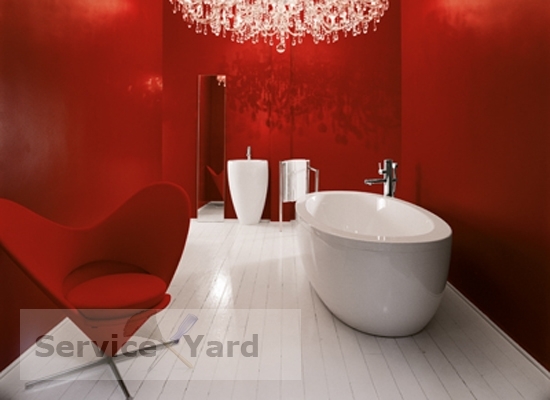
- Preparing for laying the
- coating What depends on the direction of laying?
- How is it better to put a laminate - along or across?
- Tools for laying laminate
- Options for coupling panels
- What problems can arise?
- Schemes and features of stacking
In advertising, you can increasingly see that the installation of flooring does not cause any difficulties, even for a beginner. If you just follow understandable instructions, the result is most likely to satisfy you and your loved ones. But the question arises: how best to put a laminate - along or across? In fact, there are countless nuances of this process, of which today we will talk.
to the contents ↑Getting ready for the laying of the
coating You are already thinking: how best to put a laminate? Not so fast. First you need to make sure that the coating is ready for laying.
Important! The surface on which the laminate will be laid should not have any depressions and unevenness, because the presence of such will lead to a discrepancy between the lamellar locks that connect the locks.
The next step is laying the substrate. It will help to smooth small irregularities, to keep heat and to provide soundproofing. The substrate will become a good shock absorber, which will save you from creaking when walking. The material and thickness are chosen depending on the laminate class:
- for inexpensive coating, foam polyethylene is suitable;
- for prestigious - composite substrate or expanded polystyrene, cork.
Important! The substrate must be spread over the area of the entire floor. And all connections should be glued with scotch tape.
to the contents ↑What depends on the direction of laying?
First we will understand with the types of directions of laying:
- Along.
- Cross.
- Diagonally.
The first two are usually combined into a group - straight laying. With editing, running diagonally, everything is more complicated. This way of laying is more expensive, and the process is more laborious, but this choice can be the best solution if the first two methods for some reason do not fit.
The visual perception of the room most often depends on the direction of laying, so one of the selection criteria is the expected result, let's talk about it below.
to the contents ↑How is it better to put a laminate - along or across?
Here we come to the most interesting moment. Not everything is as simple as it might seem, let's look at a few cases.
Mounting along the light line
This is the most common method. It requires the least time, knowledge and resources, and is, in fact, "classical."If you want no seams between the slats to be visible, then this is your choice. This direction will bring all chances to create the desired interior.
Mounting across the light line
This option is considered less "professional", but it has its advantages. Installation across the line of light creates a visual effect of "latitude", so this method is practiced in long corridors and rooms. But do not forget that this is a laborious process, because because of the cutting of the boards you will lose more time. 
Diagonal installation
This type of coating is used to make the room "interesting".In other words - this is a special design technique that can "dilute" the boring interior and visually change the geometry of the room.
Important! This method has several disadvantages:
- Joints are quickly erased;
- Be prepared for a large flow of material;
- I'll have to buy special chemistry for cleaning and care.
This type of installation has the most opponents, but this does not lose its popularity.
to the table of contents ↑Laminating tools
Manufacturers advise to acquire special tools, but you can do with standard tools:
- Electric jigsaw or hacksaw;
- Pencil;
- Kianka;
- Elbow;
- Roulette;
- Level;
- Plate or block for padding panels;
- Mounting crowbar.
Options for coupling the
panels When laying the floor independently, you will have to solve not only the question of how to lay the laminate better - either along or across, but also how to fasten individual elements of the coating. There are two types of clamping locks, which are now being discussed.
CLICK-locks
The lamellas are fastened by means of collapsible locks, which are robust and highly resistant to any influences. Such a system is very simple and long-serving for a long time.
Important! The clearance of such panels is almost not visible, but the installation is advised to be carried out in parallel with the source of illumination.
LOCK locks
The lamellae are secured by means of special slots on the plates. Again, it is worthwhile to focus on the light source and perform installation along the propagation of the sun's rays.
to the contents ↑What are the possible difficulties?
If the work is done without haste, it's good to think about it beforehand, then special difficulties should not arise. But it often happens that due to the loose joint of the lamellas, moisture can get under the styling and cause a number of problems. Therefore, it is worth considering all the nuances and making sure that the surface has no irregularities.
It is worth paying attention to some things before installation:
- Once again, make sure the roughness of the rough floor;
- Choose only high-quality material;
- Always use a lining;
- Keep track of the temperature;
- Follow the manufacturer's instructions;
- Inspect each board carefully for defects.
Schemes and features of stacking
First, let's look at the list of laying patterns:
- Herringbone - the location of the laminate laths at an angle of 45 °;
- Asymmetry - unordered( chaotic) installation of panels;
- Labyrinth - the formation of a variety of drawings from the components;
- Braiding - shift to the width of the bar;
- Deck - offset by a third from the previous row.
Features of
It should be understood that there are no specific features of laying, and the choice should be based on individual preferences. For convenience, we classify the styling features:
- in shape and size. Lamels are produced not only in the form of boards, you can find square and rectangular slats.
- By type of substrate. It is best to install on a well-dried and flat concrete floor.
Important! When installing on top of wood panels should be placed perpendicular to the direction of the boards.
- By design. Here everything is for taste and color - today you can find thousands of design solutions that fit into the interior you are interested in.
All these knowledge is enough to become a "master" of laying the laminate. Now you can easily create an ideal interior of the room without loss for yourself and your nerves. Feel free to do it! Remember that everything is in your hands!



